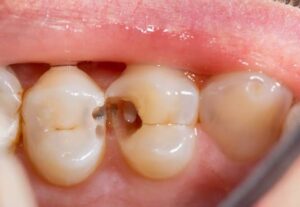
Root canal treatment is a dental procedure that replaces a tooth’s damaged or infected pulp with a root filling. The pulp is the tooth’s lifeline – its vessels, tissue fibres and nerves in the central hollow of the tooth keep it alive. The procedure to replace this damaged or infected pulp is also known as endodontic treatment.
Tooth structure

A tooth is mainly made of a hard material called dentine. Enamel is the surface layer that protects the visible part of the tooth (crown). The part of the tooth that sits beneath the gum line is called the root. The root helps to anchor the tooth into the jaw. Generally, front teeth have only one root, while molars generally have up to three. Within each root, there can be multiple canal spaces.
The hollow centre of a tooth is called the pulp chamber. This area contains the blood vessels, nerves and pulp. The pulp is a sensitive tissue that provides oxygen, nutrients and feeling to the tooth. The pulp extends from the roof of the pulp chamber down into the bottom of each root canal. If it becomes infected, the entire space needs to be disinfected.
The main function of the dental pulp is to regulate the growth and development of the tooth during childhood. Once the tooth is fully formed, nutrition for the tooth comes from the tissues surrounding the root. Therefore, a tooth can function without its pulp and, in most cases, can be kept indefinitely.
Symptoms of tooth pulp damage or disease
A diseased tooth pulp may cause inflammation or infection. The symptoms of a damaged or diseased tooth pulp may include:
unprovoked or spontaneous pain
sensitivity to hot and cold drinks and foods
pain when biting or chewing
loosening of the tooth
swelling of the gum near the affected tooth
oozing of pus surrounding the affected tooth
facial swelling
Sometimes, tooth pulp may become damaged or diseased without any symptoms. In these cases, the problem is usually diagnosed by special tests or x-rays during a dental check-up or treatment for other dental concerns.
Causes of tooth pulp damage or disease
There are many events that can lead to disease or damage to dental pulp. Some of these include:
deep-seated and untreated tooth decay
decay beneath a deep filling
trauma that damages a tooth
habitual tooth grinding (bruxism)
long-standing cracks in the teeth
advanced gum disease
Complications of tooth pulp/root canal infection
Options are available to manage tooth pulp infection, so it’s important to have this treated when you can to prevent further issues. If tooth pulp infection is left untreated, complications could include:
spreading infection – once the pulp becomes infected, it loses its ability to fight the spread of the infection. If bacteria find their way into the pulp chamber, the bacteria will multiply. This can cause an infection or an endodontic abscess (a pocket or ‘blister’ of pus) when it spreads into the surrounding bone which can become severe.
bone loss in the area – the infection may spread around the ends of the infected root canal and erode surrounding jaw bone
loss of tooth – the tooth may have to be removed, which can affect eating or appearance. Tooth replacement options are available but may be limited if the infection has already caused advanced bone loss.
Diagnosis of tooth pulp problems

The dentist will listen to your symptoms, examine your teeth and perform other investigations including taking x-rays. These x-rays also help the dentist to plan for the root canal treatment by showing the number, size, shape and depth of the roots, which shows how complicated the procedure may be.
Root canal procedure

You may need more than one visit to complete the treatment, depending on the difficulty of the procedure. The exact procedure chosen by your dentist may differ from the procedure outlined here. Ask your dentist for further information.
Root canal treatment has four main aims:
removing active decay and infection – any old or leaky fillings, tooth decay, infected nerve tissue, pus and debris are removed
shaping the canals – to be filled well, the canals within the tooth root need to be shaped into smooth, hollow tunnels that are free of irregularities where residual bacteria may sit. This shaping process involves small instruments, special disinfectants and medication. It may take a few weeks to months for these solutions to take maximum effect against stubborn bacteria within the tooth, and this step may have to be repeated several times
filling the canals – to prevent bacteria from re-infecting the empty canals in your tooth, they are permanently sealed with a long-lasting barrier material
making the tooth functional again – to make sure no bacteria from the mouth can leak back into the tooth, a large, well-sealed restoration is put on the tooth. Teeth that require root canal treatment have sometimes lost a lot of tooth structure due to previous decay or cracks, and may require further protection in the form of posts, crowns or other similar materials.
Tooth colour after root canal treatment

A normal tooth with a healthy pulp is yellowish-white in colour. A pulp-free tooth that is sealed with a filling rather than covered by a crown may eventually turn grey. The dentist can advise you on appropriate aesthetic (cosmetic dentistry) procedures to help with this.